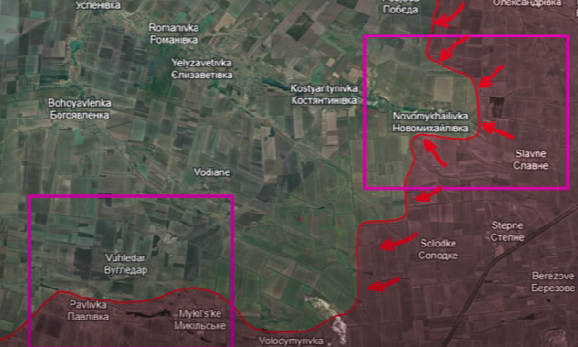Frontline report: Russia shifts focus to eastern flank in bid to take Kurakhove
Frontline villages like Novomykhailivka and Pobieda key in blunting offensive. Control of supply routes critical - Ukraine manages to reclaim half of Pobieda in counterattack.

On 29 February, there are a lot of updates from the Kurakhove direction.
Here, to reach Kurakhove, the region’s main stronghold and logistical center, Russian forces are conducting an offensive operation along the eastern part of the front line.
The reason why Russian forces shifted their activity from the southern line near Vuhledar to the eastern line near Novomykhailivka lies in the topography of the region.

Instead of trying to breach the impregnable fortress Vuhledar on the hills, Russian forces opened axes of attack along these hills to mitigate tactical disadvantages and bypass Vuhledar from the north.
In principle, this should have allowed for a consistent, faster movement through the fields toward Kurakhove. However, Russian forces quickly bumped into a formidable obstacle in the field in the form of a long line of settlements, with the village of Novomykhailivka being the first in their way.
The frontal attacks on the settlement yielded limited results, and Russian progress was quickly halted.

The main reason why Russian forces struggled to push Ukrainians out of the village with brute force was the fact that Ukrainians had much better logistics.
This allowed Ukrainians to deliver supplies of ammunition from proximate villages with relative ease and conduct counterattacks as soon as the strength of the Russian assault units sufficiently dropped in the aftermath of continued operations.

The Russian commanders were forced to reevaluate the situation and find a way to undermine Ukraine’s defensive capabilities in this region. In order to achieve this, Russian forces set an objective to cut Ukrainian supplies to the village by advancing from the flanks.
The most intense clashes have been taking place on the northern flank. The main objective of the Russian forces in this area is to capture the village of Pobieda and use it to boost their logistical capabilities to accelerate the rate of advancement on the northern flank and subsequently cut Ukrainian supply roads west of Novomykhailivka. Russian forces have been trying to take Pobieda for more than two years now.

The main problem that Russian forces previously faced was Ukrainian counterattacks from Marinka. However, after the last Ukrainian troops withdrew from Marinka more than two months ago, Russian forces effectively secured their flanks. They could start attacking Pobieda from a much more tactically advantageous position.

While previously Russians had to attack it from the fields, suffering from mines and crossfire, now Russians can use the highway for rapid mechanized assaults directly from Marinka.
Russian sources reported that to undermine the Ukrainian defense inside the village, apart from regular artillery, Russian forces also engaged heavy thermobaric artillery systems. Once the artillery preparation was over, Russians started launching mechanized assaults.
Geolocated combat footage released by Russian sources shows how Russian armored fighting vehicles are using machine guns to suppress Ukrainian fire while the Russian infantry is landing.
Once the infantry landed, the armored fighting vehicle left the scene to avoid Ukrainian ATGM and drone fire. This was not the first Russian assault, and it was also far from the last one. Ukrainians understood the importance of holding this position and resisted the Russian assaults as much as possible.
However, after several days of non-stop clashes, Russian forces managed to establish a limited presence on the eastern outskirts of the village.
According to Russian sources, Russian forces managed to get a hold of the farms on the road’s eastern side. Digging in on the outskirts simplified further offensive efforts, as they could provide fire support and amplify mechanized attacks from the north.
As a result, one of the Russian attack groups managed to use this additional fire support effectively and get to the northern part of the village and later the southern part, where they put the red flag.
Ukrainian sources confirmed the Russian presence but noted that there was a possibility for a counterattack. Russian analysts came to the same conclusion and claimed that Ukrainians will attempt to reestablish control over this tactically important settlement in the short term.

The reason why Russian forces were in a vulnerable position is twofold. First, the village is split in half by the river, making it harder to stay and supply the southern part of the village. Secondly, Ukrainian forces have a large, strong point south of the village, conveniently used for accumulating forces for possible counterattacks.
According to Russian sources, Ukrainian forces conducted a mechanized counterattack the very next day. Russian drone operators posted footage of the immobilized Leopard tank south of the village, confirming the claims of tank usage.
Nonetheless, the counterattack succeeded, and Ukrainian forces reestablished control over half of the village south of the river. Overall, Ukrainian forces managed to stop the Russian momentum and stabilize the front line along the river.
The situation remains difficult, as Russians do not give up on the idea of fast advancement from the north.
To discourage Russian forces from attacking in this direction, Ukrainian forces are improving their defenses south of the village, particularly around the dense tree area, which is hard to flank due to the small rivers in the fields east of it.
However, despite the high intensity of the fighting, the scale of these battles for the small villages in the Donetsk Oblast pales in comparison to the Battle for the Luhansk Oblast, where Russians are trying to restore maneuver warfare reminiscent of the Second World War.
Russian forces opened four mutually supporting axes of advance, which increased the risk of envelopments and encirclements.
In our daily frontline report, we pair up with the military blogger Reporting from Ukraine to keep you informed about what is happening on the battlefield in the Russo-Ukrainian war.
Read also:
- Frontline report: Why Kupiansk matters, Russia’s next major offensive target
- Frontline report: Russian troops increase pressure west of Bakhmut



